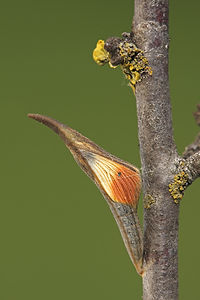top of page
This butterfly is found primarily throughout Europe and temperate Asia
It has been affected by temperature change, and it now appears approximately 17 days later in the spring season.
Male and female habitats vary significantly.
Males restrict themselves to edges and forest clearings their entire lives.
Occasionally, they will leave the forest edges to enter meadows, but this is only to reach another forest edge.
They prefer to flying in bright sunlight and avoid shaded areas in the forest.
Females are primarily found in open meadows and hills for their entire lives.
They spend only short period of time in the forest before returning to the meadows.
Females control mating, as flying virgin females are pursued by males immediately.
Females can signal different meanings to the approaching males using their abdomens.
There is some evidence that mated females have an anti-aphrodisiac and that their usage of the abdomen closely relates to the function of presenting pheromones to the males.
Males exhibit a variation in body size, which is attributed to the host plant they choose.
Those reared on C. pratensis are invariably the smaller of the two, and males reared on A. petiolata will be the larger.
Their name comes from the bright orange tips on the male's forewings.
Males are a commonly seen in spring flying along hedgerows and damp meadows searching for the reclusive females which lack the orange and are often mis-identified as other species.
Their ventral sides are a mottled green and white and are an ideal camouflage when the females land on flowers such as cow parsley and garlic mustard.

Wingspan: 45mm - 50mm / 4.5 - 5 cm / 1 3/4 - 2"
Family: Pieridae
The single biggest threat to butterfly survival is habitat destruction!!
bottom of page






